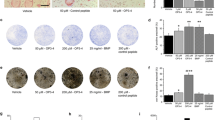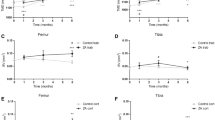Abstract
The effects of a new generation bisphosphonate, incadronate, in established adjuvant arthritis rats were evaluated according to the arthritis index, hind paw volume, and radiological and histopathological examinations. Incadronate suppressed the radiological and histopathological changes of hind paws, as well as the joint swelling in a dose-dependent manner. In contrast, the arthritis control rats showed drastic joint inflammation, marked destruction of bone and articular cartilage. The remains of articular cartilage lost Safranin O staining, and were attached with numerous TRAP-positive multinuclear cells. Some of resorption lacunas could be seen at the cartilage matrix nearby the TRAP-positive multinuclear cells. As regards the chondroprotective effects of bisphosphonates, we speculate that it is probably concerned with the inhibition of the chondroclasts. These data indicate that bisphosphonates may be a class of effective agent that can be considered for treatment of various arthritic conditions, including human rheumatoid arthritis.








Similar content being viewed by others
References
Rodan GA, Fleisch HA (1996) Bisphosphonates: mechanisms of action. J Clin Invest 97:2692–6
Harinck HI, Papapoulos SE, Blanksma HJ, Moolenaar AJ, Vermeij P, Bijvoet OL (1987) Paget’s disease of bone: early and late responses to three different modes of treatment with aminohydroxypropylidene bisphosphonate (APD). Br Med J 295:1301–1305
Thiebaud D, Jaeger P, Gobelet C, Jacquet AF, Burckhardt P (1988) A single infusion of the bisphosphonate AHPrBP (APD) as treatment of Paget’s disease of bone. Am J Med 85:207–212
Body JJ, Mancini I (2003) Treatment of tumor-induced hypercalcemia: a solved problem? Expert Rev Anticancer Ther 3:241–246
Body JJ (2000) Current and future directions in medical therapy: hypercalcemia. Cancer 88(Suppl):3054–3058
Storm T, Thamsborg G, Steiniche T, Genant HK, Sorensen OH (1990) Effect of intermittent cyclical etidronate therapy on bone mass and fracture rate in women with postmenopausal osteoporosis. N Engl J Med 322:1265–1271
Eggelmeijer F, Papapoulos SE, van Paassen HC, Dijkmans BA, Breedveld FC (1994) Clinical and biochemical response to single infusion of pamidronate in patients with active rheumatoid arthritis: a double blind placebo controlled study. J Rheumatol 21:2016–2020
Cantatore FP, Acquista CA, Pipitone V (1999) Evaluation of bone turnover and osteoclastic cytokines in early rheumatoid arthritis treated with alendronate. J Rheumatol 26:2318–2323
Havdrup T, Hulth A, Telhag H (1976) The subchondral bone in osteoarthritis and rheumatoid arthritis of the knee. A histological and microradiographical study. Acta Orthop Scand 47:345–350
Bromley M, Woolley DE (1984) Chondroclasts and osteoclasts at subchondral sites of erosion in the rheumatoid joint. Arthritis Rheum 27:968–975
Eggelmeijer F, Papapoulos SE, van Paassen HC, Dijkmans BA, Valkema R, Westedt ML, Landman JO, Pauwels EK, Breedveld FC (1996) Increased bone mass with pamidronate treatment in rheumatoid arthritis. Results of a three-year randomized, double-blind trial. Arthritis Rheum 39:396–402
Maccagno A, Di GE, Roldan EJ, Caballero LE, Perez LA (1994) Double blind radiological assessment of continuous oral pamidronic acid in patients with rheumatoid arthritis. Scand J Rheumatol 23:211–214
Barbier A, Breliere JC, Remandet B, Roncucci R (1986) Studies on the chronic phase of adjuvant arthritis: effect of SR 41319, a new diphosphonate. Ann Rheum Dis 45:67–74
Osterman T, Kippo K, Lauren L, Hannuniemi R, Sellman R (1994) Effect of clodronate on established adjuvant arthritis. Rheumatol Int 14:139–147
Podworny NV, Kandel RA, Renlund RC, Grynpas MD (1999) Partial chondroprotective effect of zoledronate in a rabbit model of inflammatory arthritis. J Rheumatol 26:1972–1982
Zhao H, Shuto T, Hirata G, Iwamoto Y (2000) Aminobisphosphonate (YM175) inhibits bone destruction in rat adjuvant arthritis. J Orthop Sci 5:397–403
Matsuo A, Shuto T, Hirata G, Satoh H, Matsumoto Y, Zhao H, Iwamoto Y (2003) Antiinflammatory and chondroprotective effects of the aminobisphosphonate incadronate (YM175) in adjuvant induced arthritis. J Rheumatol 30:1280–1290
Kinne RW, Schmidt-Weber CB, Hoppe R, Buchner E, Palombo-Kinne E, Nurnberg E, Emmrich F (1995) Long-term amelioration of rat adjuvant arthritis following systemic elimination of macrophages by clodronate-containing liposomes. Arthritis Rheum 38:1777–1790
Nishikawa M, Akatsu T, Katayama Y, Yasutomo Y, Kado S, Kugal N, Yamamoto M, Nagata N (1996) Bisphosphonates act on osteoblastic cells and inhibit osteoclast formation in mouse marrow cultures. Bone 18:9–14
Nishikawa M, Yamamoto M, Murakami T, Akatsu T, Kugai N, Nagata N (1998) A third-generation bisphosphonate, YM175, inhibits osteoclast formation in murine cocultures by inhibiting proliferation of precursor cells via supporting cell-dependent mechanisms. J Bone Miner Res13:986–995
Ito M, Amizuka N, Nakajima T, Ozawa H (1999) Ultrastructural and cytochemical studies on cell death of osteoclasts induced by bisphosphonate treatment. Bone 25:447–452
Lehmann HJ, Mouritzen U, Christgau S, Cloos PA, Christiansen C (2002) Effect of bisphosphonates on cartilage turnover assessed with a newly developed assay for collagen type II degradation products. Ann Rheum Dis 61:530–533
Garnero P, Christgau S, Delmas PD (2001) The bisphosphonate zoledronate decreases type II collagen breakdown in patients with Paget’s disease of bone. Bone 28:461–464
Teronen O, Heikkila P, Konttinen YT, Laitinen M, Salo T, Hanemaaijer R, Teronen A, Maisi P, Sorsa T (1999) MMP inhibition and downregulation by bisphosphonates. Ann N Y Acad Sci 878:453–465
Van Offel JF, Schuerwegh AJ, Bridts CH, Stevens WJ, De Clerck LS (2002) Effect of bisphosphonates on viability, proliferation, and dexamethasone-induced apoptosis of articular chondrocytes. Ann Rheum Dis 61:925–928
Johnson WJ, DiMartino MJ, Hanna N (1986) Macrophage activation in rat models of inflammation and arthritis: determination of markers of stages of activation. Cell Immunol 103:54–64
Luckman SP, Hughes DE, Coxon FP, Graham R, Russell G, Rogers MJ (1998) Nitrogen-containing bisphosphonates inhibit the mevalonate pathway and prevent post-translational prenylation of GTP-binding proteins, including Ras. J Bone Miner Res 13:581–589
Nakamura M, Ando T, Abe M, Kumagai K, Endo Y (1996) Contrast between effects of aminobisphosphonates and non-aminobisphosphonates on collagen-induced arthritis in mice. Br J Pharmacol 119:205–212
Mashiba T, Turner CH, Hirano T, Forwood MR, Johnston CC, Burr DB (2001) Effects of suppressed bone turnover by bisphosphonates on microdamage accumulation and biomechanical properties in clinically relevant skeletal sites in beagles. Bone 28:524–531
Mashiba T, Hirano T, Turner CH, Forwood MR, Johnston CC, Burr DB (2000) Suppressed bone turnover by bisphosphonates increases microdamage accumulation and reduces some biomechanical properties in dog rib. J Bone Miner Res 15:613–620
Komatsubara S, Mori S, Mashiba T, Ito M, Li J, Kaji Y, Akiyama T, Miyamoto K, Cao Y, Kawanishi J, Norimatsu H (2003) Long-term treatment of incadronate disodium accumulates microdamage but improves the trabecular bone microarchitecture in dog vertebra. J Bone Miner Res 18:512–520
Acknowledgments
The authors thank Yamanouchi Pharmaceutical CO., Ltd., for kindly providing incadronate (YM175), and Mr. Takaaki Kanemaru, Mr. Masaharu Magara and Miss Naoko Tanaka for their excellent technical assistance.
Author information
Authors and Affiliations
Corresponding author
Rights and permissions
About this article
Cite this article
Zhao, H., Liu, S., Huang, D. et al. The protective effects of incadronate on inflammation and joint destruction in established rat adjuvant arthritis. Rheumatol Int 26, 732–740 (2006). https://doi.org/10.1007/s00296-005-0061-8
Received:
Accepted:
Published:
Issue Date:
DOI: https://doi.org/10.1007/s00296-005-0061-8




